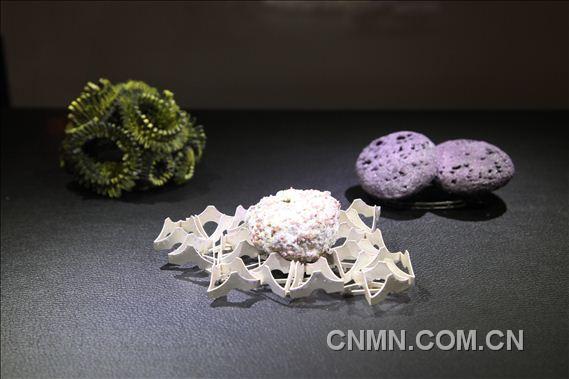金属艺术的历史|从原矿到金属艺术品·2013国际当代金属艺术展研讨
2013年11月05日 0:47 12192次浏览 来源: 中国有色网·有色赏鉴频道专稿 分类: 铜器 作者: 田田

2013国际当代金属艺术展 金属艺术品

2013国际当代金属艺术展 金属艺术品

2013国际当代金属艺术展 金属艺术品

2013国际当代金属艺术展 金属艺术品

2013国际当代金属艺术展 金属艺术品
(专题报道稍后呈现)
中国有色网·有色赏鉴频道专稿 金属是地球赐予人类最宝贵的财富之一。坚硬、导电、传热和延展性等天然属性,使金属材质自从人类发现之后,就伴随着人类社会的文明与进步,成为人们社会生活中从古至今不可或缺的材质。
金属中的金、银、铜、铁、锡等是人类用来制作艺术品的最古老最常见的材质。早在原始时代,人们发现了暴露在自然中的金块和铜块,融化后变的比陶坚固,可以用来制作劳动工具和狩猎武器。比较柔软的黄金可以制作薄薄的饰品,加上独特耀眼的光泽,用来祭祀神灵和装饰生活。金属特别是贵金属的稀有和珍贵,又被赋予诸多的社会属性,成为社会地位、身份、财富的表征。
金属制作技术作为人类智慧、才能和艺术的体现,因地域不同、民族不同和文化不同,又呈现出异常丰富多彩的变化。四大文明古国的西亚两河流域的苏美尔人、巴比伦人、亚述人和波斯人在创造了最早的庙宇、宫殿、楔形文字的同时,金属铸造和手工锻造的艺术品堪称金属艺术最早的典范。北非的埃及人对黄金独有衷爱,精美的黄金饰品、上釉彩色饰品,开创了珐琅工艺的先河。东亚华夏民族,创造了以铸造工艺著称的青铜器艺术,其造型宏大,独具风格,在世界金属艺术中独树一帜。南亚印度人的金属作品制作精湛而富有浓重的宗教色彩。位于地中海克里特和迈锡尼岛出土的黄金饰品,奠定了欧洲人审美精神和艺术风格的基础。在人类历史的长河中,金属艺术和各种工艺技能,随着战争、商贸、文化等方式不断地在传播、交流,促进了人类相互学习、沟通和文化与文明的进步。
工业革命以后,机械的使用打破了以往手工制作的方式,带来了生产力和社会阶层结构的深刻变革。科学技术、商品经济、新观念、新思潮风起云涌,激荡着金属艺术迅速发展,进入一个不断创新、不断变化的历史新纪元。以钢铁为特征的工业时代,科学技术日新月异,使金属材质更加多样化的在城市、建筑、交通、运输以及衣食住行用等各个方面,发挥着空前的作用,处处留下了金属的建树。金属艺术更多地服务于新的内涵而被无限扩展。
以第三产业和消费经济为主导的“后现代”社会,新的价值体系和生活方式,极大的影响着金属艺术更加贴近社会,贴近生活。一向昂贵的金属艺术,亦在文化与艺术的阐释中发生着内涵与功能作用的全新改变。各国的金属艺术家们基此,正以各自不同的文化背景、工艺技能,体验与感受表达并呈现出他们对生活、社会、自然的认识和理解。在互动中体现着时代的变化,在创新中实现着艺术的发展。或许,我们从中亦可窥见国际金属艺术某些未来的走向。
The History of Metal Art
Metal is one of the most valuable treasures that our living earth has given to us. The natural characteristics of flintiness, conduction, heat transmission and ductility, have made metal grow with the pace of human society’s civilization and progress. This situation began from the discovery of the metal and as time went by, metal has become a kind of indispensible materials for people’s living from ancient time to now.
The gold, silver, copper, iron and tin are the oldest and most conventional metals to be used for artworks. As early as in rude times, people found that bulks of gold and copper were exposed in the nature and these metals became harder than pottery after melting them. These metals could be used to build labor equipments and hunting arms. Metals which were softer, such as gold, could be applied to make accessories of thin pieces, and the unique shine of the gold made it proper for decorating the daily life and sacrificing for the gold. The metals, especially those which are rare and precious, were given many kinds of social attributes and became the representations of social status and richness.
The fabrication of metals, as the representatives of human kinds’ wisdom, talents, and arts, varied a lot with the differences of regions, nations and cultures. The Sumerians, the Babylonians, the Assyrians and the Persians who were living on the Mesopotamia in West Asia, built the earliest temples, palaces and invented the first Cuneiform while as the same time, their art pieces of metal casting and blacksmithing were the earliest work models for their times. The Egyptians in North Africa had a unique love for gold and they built fine golden and glazed color jewelries, which opened the first kind of Enamel workmanship. The Chinese nation in East Asia, invented the well-known casted Bronze, which had lead an unique part in the metal arts around the world. The Indians in the South Asia created art crafts which were beautiful and full of religious elements. The golden accessories which were founded in the Mediterranean island of Crete and Mycenae established the Europeans’ aesthetic spirits and art styles. In the course of history, the metal arts and many kinds of skills had spread and communicated with the spreading of wars, commerce and cultures. This greatly promoted communications among different cultures and enhanced the progress in the civilization and culture.
After the industrial revolution, the application of mechanics broke the conventional hand-making style and brought the vast changes in productivity and social class structures. The technology and science, the commodity economy, all kinds of new concepts and new trends, all promoted the metal arts to develop quickly and metal arts were entering into a new era. The industrial era with steel as its symbol, developed quickly as the new science and technology and metals found more and more space in the applications of city innovation, buildings, transportations and basic necessities of lives, and metal arts left a lot for the history in this period.
In the “post-modern” society leading by the service sector and consumption economy, the new philosophy of living and values has greatly forced the metal arts to get close to the society and everyday life. Those metal arts which were expensive before are on the way of changing their functional and intentional effects in their explanation of arts and cultures. Just because of this, the artists from different countries are feeling, experiencing and providing their comprehension for living, the society and nature on their own culture backgrounds and skills. We are trying to reflect the changes of our time by communicating and achieve the progress of metal arts by innovation. We might find out the future trends of global metal arts from these pieces.
喜爱金属艺术的朋友欢迎加QQ群:167085729 i中国金属
联系人:刘小姐 email:1716703582@qq.com
“有色赏鉴·金属工艺品频道”:中国有色金属报是国务院国资委举办,中国有色金属工业协会主管,中国有色金属行业唯一的行业权威性报纸,开设了国内首家以金属工艺品为主要宣传对象的媒体平台“有色赏鉴·金属
责任编辑:田田
如需了解更多信息,请登录中国有色网:www.yujingqiu.com了解更多信息。
中国有色网声明:本网所有内容的版权均属于作者或页面内声明的版权人。
凡注明文章来源为“中国有色金属报”或 “中国有色网”的文章,均为中国有色网原创或者是合作机构授权同意发布的文章。
如需转载,转载方必须与中国有色网( 邮件:cnmn@cnmn.com.cn 或 电话:010-63971479)联系,签署授权协议,取得转载授权;
凡本网注明“来源:“XXX(非中国有色网或非中国有色金属报)”的文章,均转载自其它媒体,转载目的在于传递更多信息,并不构成投资建议,仅供读者参考。
若据本文章操作,所有后果读者自负,中国有色网概不负任何责任。

